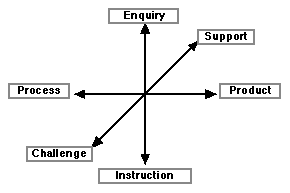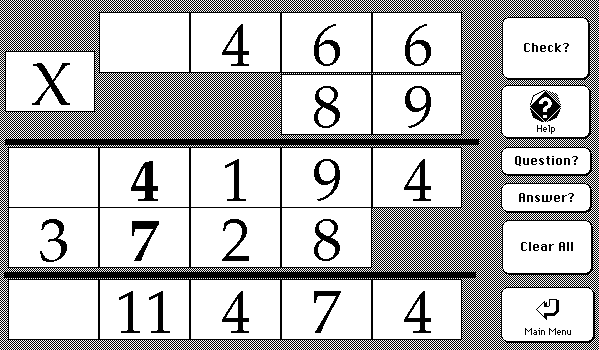

Stephen Arnold, AAMT
If one changes the tools of thinking available to a child, his mind will have a radically different structure. (Vygotsky, 1978, p. 126)
INDEX
Mathematics has always been a tool-based activity. In the past, those tools have taken a variety of forms, from paper and writing implements to ruler and compasses; even the symbolic language of mathematics is a tool which supports our thinking. From this point of view, the distrust which many teachers feel towards the new technological tools now available for the teaching and learning of mathematics is misplaced. But of course, doing mathematics has always been quite different to teaching and learning mathematics. In this address, I intend to look closely at this process of teaching and learning mathematics and the role which the tools of technology may play. There seems now little doubt that computer technology in its many forms can and must impact upon the ways in which we present mathematics to our students; in fact, in some ways technology is transforming the nature of mathematics itself. But what about the "real world" and the place of technology now and in the near future? What about that low ability Year 9 class last thing on a Friday afternoon? While the issues we will consider are big ones, let us not wander too far away from the realities of school as it is today.
The direction of this talk will be largely determined by three main areas of focus: the tools themselves, those that use them, and the context in which this occurs. For the first issue, we will briefly look at samples of the technology as it is unfolding, in both hand-held and desktop forms. Examples will be presented which seem to me to demonstrate the features which we should expect in quality software tools. The second focus, the students that use the technology, reports upon a three-year study which I recently undertook for my doctoral work, resulting in a thesis entitled: Learning to use new tools: A study of mathematical software use for the learning of algebra. For three years, I worked with teachers, student teachers and students. I watched and learned as students, in individual tutorial situations, made use of available software tools - computer algebra, graphing and tables of values in particular. I learned much about the ways in which people interact with technology, and some of the effects of the tool upon the user.
Underlying both the tools and those that use them, of course, is the culture of mathematics learning within which we all operate and which we ourselves (teachers, students, curriculum developers, examiners, parents and others) all work to create. Where does the new technology fit into this culture, and what will be the result of the irresistible force meeting the immovable object? It seems useful to begin, then, with the context of mathematics learning, within which technology and those that would use it must function.
A MODEL OF MATHEMATICS LEARNING
What does it mean to teach well? Surely the measure of our effectiveness as teachers lies in the quality of our students' learning. I was told that one of many mottos used at the Massachusetts Institute of Technology (MIT) was: "If they didn't learn, I didn't teach." That is a pretty tall order, considering the variety of students who cross our paths every day of every year in the classroom. And yet I cannot help but agree with the sentiment, and if nothing more, it gives me something to aim for as a teacher.
I have spent a lot of time in recent years thinking about learning, about classrooms and about the place of technology in all this. While not denying the complexities of the classroom, I find it useful to imagine a three-dimensional model for mathematics teaching and learning, as shown in Figure 1. In this context, good teaching is that which strikes a balance between each of the three dimensions: Between process and product, between instruction and enquiry, and between challenge and support.
Figure 1: A three-dimensional model of mathematics teaching and learning

There is a clear tension associated with each of these distinctions. Consider that between process and product. To which end does traditional mathematics instruction lean? It remains true that most of our students associate mathematics with "finding an answer" - often any answer, whether it is correct or not. Knowingly or unknowingly (and most particularly through our assessment practices) we reinforce and reward this perception. And technology has a role to play, too. The most ubiquitous and successful example of the use of technology in mathematics classrooms at all levels is the hand calculator. It is a burning beacon which illustrates the successful incorporation of new practice into teaching. And yet the single line display sends a powerful message to our students that all that really matters is the answer. The fact that students are unable to review the process, to retrace their steps, even to verify correct entry, quietly and powerfully reinforces this message.
Of course the process is important, we say. We spend so much time drilling and consolidating algorithms and processes from the earliest years. Can we use technology, not only to produce an answer, but to support the processes of mathematics which remain so important? Consider the following two examples, one drawn from the Primary school and one from high school.
Figure 2: Nomi's Operations

A couple of years ago, my daughter was in Year 4 and having trouble with the long multiplication algorithm they were studying in class. Working with her, I developed a simple software tool using HyperCard on the Macintosh as a means for her to practise (Figure 2). The emphasis was to be upon the process, in such a way that any errors would be highlighted where they occurred and support was given throughout the sequence of activities. The format was intended to simulate the way in which the procedures were to be carried out using pen-and-paper. Note the use of bold style to draw attention to the current part of the procedure (in this case, adding 4 and 7). The student enters the two-digit sum as it occurs (as "11"); upon pressing the ENTER key, the tens digit is transferred to the next place, under the 3. Use of the technology supports and leads naturally to traditional methods.
Figure 3: SyMan 1.2

One of my favourite algebra programs for high schoolers (especially in the junior years) is a little package called SyMan (Figure 3). Available, alas, only on the Macintosh, it supports the process of equation solving very simply, in the same way that we teach our students with pen and paper. Students are supported in learning the process, but equipped to move readily from computer to traditional tools. Good software for mathematics (what I call pedagogically appropriate software) does not "short-circuit" the mathematical process, it offers effective scaffolding which, when no longer needed, may be gradually removed to reveal a free-standing structure.
And what about the process of exploration? What about checking that answer in multiple ways? Perhaps even critically examining in how many different ways that same result could have been produced. The new technology offers students the capabilities to explore their mathematics and the support to look further and in different ways than may otherwise have been possible. It empowers them and gives them control over numbers, geometry, algebra and statistics which goes beyond that which they could do unaided.
It is this aspect of the technology which leads us to consider the second dimension: the tension between instruction (which is teacher-centred, in which teacher and text are the sources of knowledge and direction) and enquiry (where the students share the responsibility for their own learning). We create so many of our own problems as mathematics teachers by distancing students from their own learning, by removing their sense of ownership and responsibility. The new technology, in giving students the freedom to explore mathematics, may well help to return this feeling of power to them, replacing the current overwhelming powerlessness which so many feel.
Many of the problems encountered by those of us who have tried to incorporate new teaching technologies and techniques into our classrooms have arisen simply because we have tried to adapt the technology to our old methods of instruction. Tools which empower students are not well suited to rows of desks, where students learn their mathematics quietly and in isolation. Rather, they reward an active learning environment, in which students work in pairs and in small groups, free to discuss, compare and to argue about their mathematics. The "centre" of the classroom must move from a small space around the chalkboard out into the middle and corners of the room. Mathematics should not be a "spectator sport."
The role of the teacher within a technology-rich learning environment must be quite different to that in the past. Students who are actively involved and responsible for their own learning do not need to be given constant direction. Students working in cooperative pairs will tend to sort out many of their problems (both mathematical and technological) without the need for teacher intervention. The teacher is freed to move around, to challenge, to assist and to pull together the various strings of learning at critical times.
The final dimension, that of challenge and support, has already been discussed to a large extent. Vygotsky talked of a zone of proximal development - the distance between what a student can do alone and unaided and that which can be achieved with support. This assistance can be provided by a tutor, a peer or even by an appropriate technological tool. Effective scaffolding allows the learner to go beyond what could normally be reached, but in such a way that it is gradually withdrawn, leaving the learner independent. Using the simple HyperCard program above, Naomi was assisted to navigate across her zone of proximal development, supported in learning the process, but then encouraged to continue alone and unaided. As any experienced teacher knows, it is not difficult to support students in their learning. The challenge lies in knowing when to withdraw that support. Too soon, and the learner becomes frustrated, too late and independence is stifled. The scaffolding offered by technology must be constructed in such a way as to offer adequate support without encouraging dependence on the part of the learner.
The new tools of technology offer many opportunities for teaching and learning mathematics. In many ways, we remain stranded at the door - sensing the promise within but unsure as to how it may best be grasped. The only answer is to take that first step, to try new things in our own classrooms, to read and listen to others, and to learn together how best to use these wonderful new tools.
Index